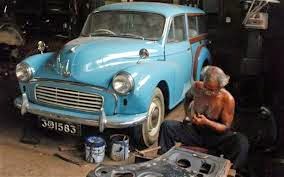
I can't talk Sinhala and my endeavors to claim the Sri Lankan spot names just met with perplexed declarations. In any case everybody knew precisely where I needed to go when I said the 'Morris Minor Garage'.
Simply a couple of miles from the noteworthy town of Galle, in the south of the island, where decently heeled travelers taste lattes in upmarket bistros, the organization is hand-production repair boards to help keep one of Britain's best-adored exemplary autos out and about.
It's authoritatively known as the Durable Car Company and produces 89 sections for the Minor, from unpredictable ledge areas and crossmembers for cantinas to finish new body for vans and pick-ups. What's more it has recently started the assembling of guard edges in stainless steel.
Secured by resigned negotiator and Sri Lankan agent Dhanapala Samarasekara in 1992 with Charles Ware, holder of the eponymous Morris Minor Center in Bristol to which it supplies its boards, it now utilizes 21 full- and low maintenance neighborhood individuals in a range where talented work is elusive.
The name reflects the reasoning of its authors who trust it is ideal to repair something than supplant it. For sure, Samarasekara rails against the arranged out of date quality of contemporary autos, depicting it as "a wastage of human exertion".

Encompassed by palm trees, the open-sided processing plant echoes to the harsh beat of various mallets as specialists skilfully put the completing touches to boards cut from sheet steel and pressed into shape on old machines. By them are stacked glossy new crossmembers, ledge areas and motor cove boards prepared for painting.
In today's cutting edge world, the organization's generation systems may seem dated with its utilization of simple tooling and accentuation on manual completing. Be that as it may it bodes well for moderately little generation runs, clarifies chief and production line administrator, Somasiri.
Furthermore to have the capacity to imitate frequently unpredictable boards utilizing such basic gear is a demonstration of the aptitude of the laborers. Some of them have been prepared by the organization since leaving school while others brag many years of experience, in the same way as senior hand Wimalasiri.
Boards are checked out on sheet steel utilizing a format and cut by hand before being pressed by machine into the obliged shape utilizing high quality 'molds'. Different presses are utilized to punch out openings or structure the folds and dimples that give the boards their inflexibility. Last completing is performed with sledges, chilly etches, processors and documents.
In spite of the fact that the emphasis is on "underfloor" parts, as opposed to the Minor's curvaceous wings which would oblige extraordinary interest in machines and tooling, the production line has delivered various body boards for the uncommon Minor pick-up. Laborers gladly demonstrated to me the new back side boards they had made for a pick-up in the workshop, alongside its heap floors, guard flitch board and even the tailgate with its trademark square dimples.
Shockingly, Sri Lanka's atmosphere is not as kind to autos as may be normal; overwhelming storms and salt air on the coast implies Minors there rust as gravely as those in Britain, if not all the more so. Which is the reason the organization additionally completes full reclamations for neighborhood lovers.
"Individuals who can bear the cost of it bring their auto to us for restoration on the grounds that they love it," says Somasiri, indicating the 1960 dark four-entryway auto they're restoring for the nephew of the nation's leader, Mahinda Rajapaksa. "It was a wreck!" he reviews. Overlooked for a long time and pulled in on the once more of a truck, it required far reaching work including new floors, case areas and body boards.

Accountable for rebuilding efforts is Chandrasiri, a bodywork repair master who's worked there for a long time. Shirtless and sandalled in the midday heat, he formed a custom repair area for a rusted entryway effortlessly borne of years of experience. As I viewed, he gauged, clipped, pounded, checked and pounded again until it fitted like the last piece in a jigsaw. Later he demonstrated to me another canal segment he'd made that looked as though it could have originated from the first manufacturing plant.
In the mean time, motors and gearboxes are sent away for remaking, and substitution mechanical and electrical segments are transported in from the UK. Experts are accumulated to complete resprays or repair the wood on the timbered Minor Traveler model.
There are assessed to be upwards of 4,000 Minors still out and about in Sri Lanka, a long ways from their prime in the 1960s and 1970s when they gave dependable transport to numerous families and even served as taxis. "It was, exceptionally well known before the entry of the Japanese autos," reviews Somasiri, himself a previous Minor holder. "It was sensibly evaluated, strong and individuals were extremely partial to it on the grounds that it was not difficult to drive with low running expenses."
More than after 40 years and the auto still orders awesome friendship in the previous British province, he clarifies: "Individuals know it as a British auto and they trust it is great that it is kept as a relic."
Little ponder that the Galle transport station supervisor had radiated with joy when I let him know where I needed to go. Gladly letting me know he possessed a 1953 Minor, he actually escorted me to the right transport as though I were eminence and gave strict directions to the conductor to let me off at the Morris Minor Garage.



